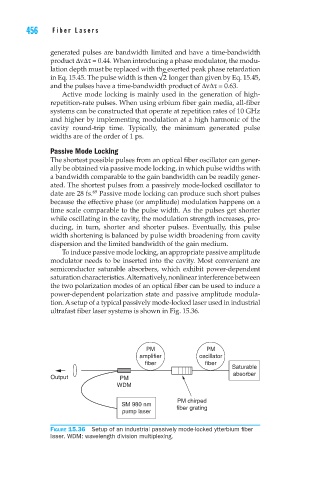Page 488 - High Power Laser Handbook
P. 488
456 Fi b er L a s er s Intr oduction to Optical Fiber Lasers 457
generated pulses are bandwidth limited and have a time-bandwidth
product ∆ν∆τ = 0.44. When introducing a phase modulator, the modu-
lation depth must be replaced with the exerted peak phase retardation
in Eq. 15.45. The pulse width is then 2 longer than given by Eq. 15.45,
and the pulses have a time-bandwidth product of ∆ν∆τ = 0.63.
Active mode locking is mainly used in the generation of high-
repetition-rate pulses. When using erbium fiber gain media, all-fiber
systems can be constructed that operate at repetition rates of 10 GHz
and higher by implementing modulation at a high harmonic of the
cavity round-trip time. Typically, the minimum generated pulse
widths are of the order of 1 ps.
Passive Mode Locking
The shortest possible pulses from an optical fiber oscillator can gener-
ally be obtained via passive mode locking, in which pulse widths with
a bandwidth comparable to the gain bandwidth can be readily gener-
ated. The shortest pulses from a passively mode-locked oscillator to
69
date are 28 fs. Passive mode locking can produce such short pulses
because the effective phase (or amplitude) modulation happens on a
time scale comparable to the pulse width. As the pulses get shorter
while oscillating in the cavity, the modulation strength increases, pro-
ducing, in turn, shorter and shorter pulses. Eventually, this pulse
width shortening is balanced by pulse width broadening from cavity
dispersion and the limited bandwidth of the gain medium.
To induce passive mode locking, an appropriate passive amplitude
modulator needs to be inserted into the cavity. Most convenient are
semiconductor saturable absorbers, which exhibit power-dependent
saturation characteristics. Alternatively, nonlinear interference between
the two polarization modes of an optical fiber can be used to induce a
power-dependent polarization state and passive amplitude modula-
tion. A setup of a typical passively mode-locked laser used in industrial
ultrafast fiber laser systems is shown in Fig. 15.36.
PM PM
amplifier oscillator
fiber fiber
Saturable
absorber
Output PM
WDM
PM chirped
SM 980 nm fiber grating
pump laser
Figure 15.36 Setup of an industrial passively mode-locked ytterbium fiber
laser. WDM: wavelength division multiplexing.

